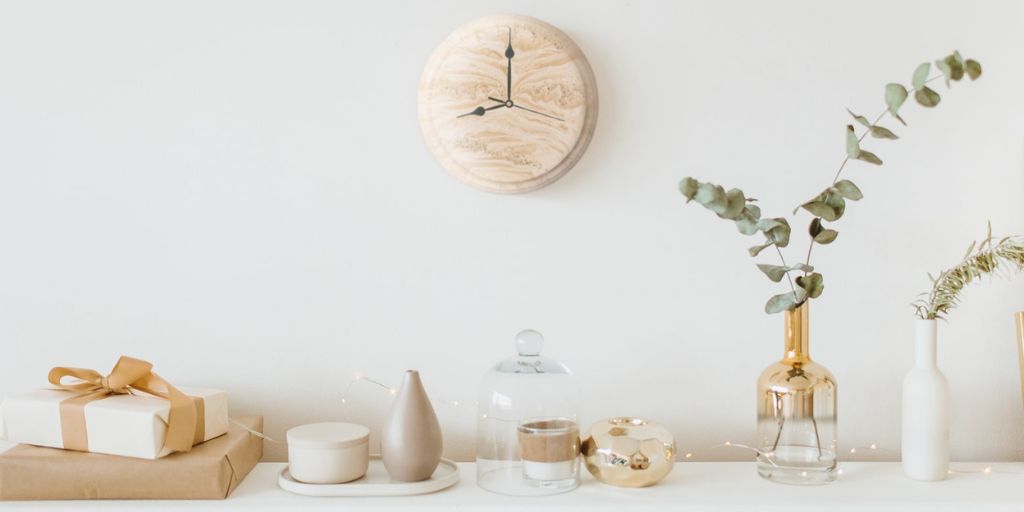With seasonal changes on the horizon, have you been thinking about shaking up your living space with some changes of your own? If there’s a blank wall that’s staring you down, why not fill it up with a work of your own creation? Today’s DIY wall clock project might be just what you’re looking for!
Making a resin wall clock is a great home decor DIY for those of all skill levels because of the flexibility and customization options available. Even the geode resin wall lock covered in this tutorial can be made in dozens of different ways to fit your space.
Tools You Will Need:
- Wooden clock blank
- Wall clock movement mechanism parts + battery
- Promise Table Top Epoxy
- Measuring and mixing cups
- Stir sticks
- Nitrile gloves
- Alumilite white and brown dye
- Mica powder of your choice (in bronze galaxy, gold metallic, and yellow pearl)
- Crushed gold craft crystals/stones
1. Prep Your Workspace
The first step in creating your own DIY wall clock with a geode resin pattern is to assemble all of your supplies in your workspace. We recommend placing plastic sheets over your work surface to make any messes easier to clean.
Once that's done, put on your gloves, and get ready to measure and mix your resin!
2. Measure & Mix
Promise Table Top Epoxy Resin is measured and mixed in a 1-to-1 ratio by volume. To do so, take an estimate of the total amount you’ll need and divide it by two. Each part will be equal parts A (resin) and B (hardener).
Combine and mix those parts together for several minutes until it’s clear and there are no striations. Next, we’ll divide the resin and add colors.
3. Mix the Colors
The design that we’re creating involves a few different colors, which means we’re need to evenly split up the resin we’ve mixed. Add a dash of each color you want to separate cups. It’s better to start out with small amounts and add more in later if needed.
We’ll have a separate cup for white, a combination of brown and white to make a beige, and the three resin powder colors. Make sure each color is the exact shade you want before you move on.
You’ll want your clock to lie flat the entire time you’re pouring the colors. It also helps to use some small plastic cups or something similar to prop it up so that excess resin can drip off. This will also ensure that the resin self-levels and remains even on the clock surface.
4. Combine Colors
One of the tricks to creating a multicolor marble effect is to combine all the colors you want to be showcased in your design. Doing this involves using an exotic pour, so we’ll guide you through this process using the colors we chose!
The key is to pour all the different colors into a single bucket, one at a time. Keep in mind that, for the most part, the first color in the bucket will be one of the last ones to leave, so it will likely be visible at the top of the pattern. We chose to pour our colors into the center of the bucket, but you can pour them wherever you’d like.
5. Pour Your Colors to Create Patterns
Carefully pour the mixture you’ve prepared onto your clock. We used a zigzag pattern to help spread the colors out further, but we always kept the pattern flowing in the same general direction. It’s fun to watch as you pour and see how the different layers of colors spill out as you pour.
6. Glam It Up
Our last bit of flair for this pieces comes in the form of some crushed gold craft crystals. Using a small measuring cup, we sprinkled bits of the stone bits along some of the lines established by the pour. Combining them with resin is unnecessary, as the current pour of uncured resin will give the stones something to adhere to.
7. Drip Management and Cure
During the curing process, you may want to go around and ‘manage’ the dripping of resin that will occur. Take a paint stick or something similar, and scrape away the excess drips from the bottom. If you do this, you won’t have to go through the process of sanding and smoothing the surface later!
After 24 hours, your project should be cured, and then you can assemble the hardware for your DIY wall clock. You’ll probably find that there was some resin dripped down the center of the clock blank. That’s to be expected! You can remove it using a tool like an X-Acto knife before we putting in the hardware. Most wall clock blanks will have a predrilled hole for the hardware, but if what you chose doesn’t, you can always drill one yourself.
The hardware installation process is fairly self-explanatory; the battery attaches to the back of the clock and the hands connect to it on the front.
Watch The Full Tutorial Here 👇
The clock is now complete and ready to be displayed. With the neutral color scheme we chose, this clock design is suitable all kinds of spaces. However, you can choose as vibrant or as neutral a color palette as you want.
Share your resin DIYs with us on social media.
Happy making!


